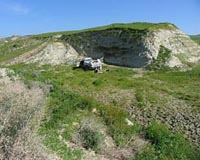| . |  |
. |
Paris (AFP) June 17, 2009 A young dinosaur that fatefully wandered into a mudpool around 155 million years could help explain the mysterious evolution of birds, says the world's most famous fossil-hunter. A team led Xing Xu, a Chinese dino expert with scores of astonishing finds to his name, uncovered the fossilised remains of a small, exceptional dinosaur in the Shishugou Formation in western China's Junggar Basin. The creature is the only known beaked herbivorous therapod -- the family of two-legged dinosaurs that were notorious meat-eaters -- from the Jurassic era, they report in Nature, the London scientific journal. Xu's team have dubbed it Limusaurus inextricabilis, or dinosaur that could not extricate itself from the mire. It is the first known ceratosaur, a branch of the theropod family, to be found in Asia. But Limusaurus' big interest is in its feet, which could settle a raging argument about the evolution of birds. A widely-accepted theory is that birds emerged from small therapod dinosaurs, developing wings from reptilian forelimbs. The earliest known bird, Archaeopteryx, lived around 150 million years ago. But in the late 1990s, evidence came forward that appeared to punch a hole in the bird-dino idea. Therapods have digits corresponding to the first, second and third digits -- the thumb, index and middle finger -- on a human hand. But scientists discovered that in bird embryos, all five digits start to emerge, yet only the second, third and fourth digits survive to develop into the wing structure. The first and outer digits disappear. In other words, the 1-2-3 of dino digital orthodoxy ran into the 2-3-4 of avian digital reality. There was no way that bird's wings could have developed this way, said critics. They claimed either theropods were not the forerunners of birds -- or else theropods and birds shared some pre-dino common ancestor. But the new study shows that Limusaurus, startlingly, has a greatly-reduced first digit, while its second, third and fourth digits are far more fully developed. This could be a sign of a process by which digit use shifted, with ceratosaurs as a sort of halfway house, argues Xu. Xu, of the Institute of Vertebrate Palaeontology and Palaeoanthropology in Beijing, backs this theory by doing a three-way comparison between Limusaurus, primitive therapods and early tetanurans, a therapod sub-group from which Archaeopteryx emerged. Early tetanurans have similar wrist-bone features to Limusaurus when it comes to digits 2-3-4. But their finger-bone features are more similar to primitive therapods in digits 1-2-3. "The transition to tetanurans involved complex changes in the hand including a shift in digit identities, with ceratosaurs displaying an intermediate condition," he suggests. Share This Article With Planet Earth
Related Links Explore The Early Earth at TerraDaily.com
 California coastal bay rich with fossils
California coastal bay rich with fossilsBakersfield, Calif. (UPI) Jun 6, 2009 A former coastal bay near Bakersfield, Calif., is filled with the fossilized remains of marine animals whose species have long gone extinct, scientists say. Scientists from the University of California-Berkeley said the Sharktooth Hill site could be seen as the richest fossil site in the entire world -- a layer of fossils offers clues to animal species dating back to 15 million years ... read more |
|
| The content herein, unless otherwise known to be public domain, are Copyright 1995-2009 - SpaceDaily. AFP and UPI Wire Stories are copyright Agence France-Presse and United Press International. ESA Portal Reports are copyright European Space Agency. All NASA sourced material is public domain. Additional copyrights may apply in whole or part to other bona fide parties. Advertising does not imply endorsement,agreement or approval of any opinions, statements or information provided by SpaceDaily on any Web page published or hosted by SpaceDaily. Privacy Statement |